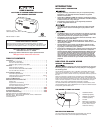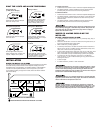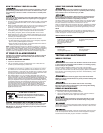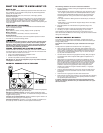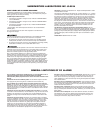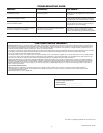
5
WHAT LEVELS OF CO CAUSE AN ALARM?
Underwriters Laboratories Inc. UL2034 defines 3 specific alarm points by
which all residential CO Alarms must alarm. They are measured in parts per
million (ppm) of CO over time (in minutes).
UL2034 Required Alarm Points*:
• If the alarm is exposed to 400 ppm of CO, IT MUST ALARM BETWEEN
4 and 15 MINUTES
• If the alarm is exposed to 150 ppm of CO, IT MUST ALARM BETWEEN
10 and 50 MINUTES.
• If the alarm is exposed to 70 ppm of CO, IT MUST ALARM BETWEEN
60 and 240 MINUTES.
* Approximately 10% COHb exposure at levels of 15% to 95% Relative
Humidity (RH).
The unit is designed not to alarm when exposed to a constant level
of 30 ppm for 30 days.
CO Alarms are designed to alarm before there is an immediate life threat.
Since you cannot see or smell CO, never assume it’s not present.
• An exposure to 100 ppm of CO for 20 minutes may not affect average,
healthy adults, but after 4 hours the same level may cause headaches.
• An exposure to 400 ppm of CO may cause headaches in average, healthy
adults after 35 minutes, but can cause death after 2 hours.
This CO Alarm measures exposure to CO over time. It alarms if CO levels are
extremely high in a short period of time, or if CO levels reach a certain mini-
mum over a long period of time. The CO Alarm generally sounds an alarm
before the onset of symptoms in average, healthy adults.
Why is this important? Because you need to be warned of a potential CO
problem while you can still react in time. In many reported cases of CO expo-
sure, victims may be aware that they are not feeling well, but become disori-
ented and can no longer react well enough to exit the building or get help.
Also, young children and pets may be the first affected. The average healthy
adult might not feel any symptoms when the CO Alarm sounds. However,
people with cardiac or respiratory problems, infants, unborn babies, pregnant
mothers, or elderly people can be more quickly and severely affected by CO.
If you experience even mild symptoms of CO poisoning, consult your doctor
immediately!
This CO Alarm is intended for residential use. It is not intended for use in
industrial applications where Occupational Safety and Health
Administration (OSHA) requirements for carbon monoxide detectors must
be met.
CO Alarms will not work without power.
This CO Alarm requires a continu-
ous supply of AC power. Plug into an unswitched 120V AC outlet only.
This CO Alarm will not sense carbon monoxide that does not reach the
sensor. This CO Alarm will only sense CO at the sensor. CO may be present in
other areas. Doors or other obstructions may affect the rate at which CO
reaches the CO Alarm. For this reason, if bedroom doors are usually closed at
night, we recommend you install a CO Alarm in each bedroom and in the hall-
way between them.
CO Alarms may not sense CO on another level of the home. For example,
a CO Alarm on the second level, near the bedrooms, may not sense CO in the
basement. For this reason, one CO Alarm may not give adequate warning.
Complete coverage is recommended. Place CO Alarms on each level of the
home.
CO Alarms may not be heard. The alarm horn loudness meets or exceeds
current UL standards of 85 dB at 10 feet. However, if the CO Alarm is installed
outside the bedroom, it may not wake up a sound sleeper or one who has
recently used drugs or has been drinking alcoholic beverages. This is espe-
cially true if the door is closed or only partly open. Even persons who are
awake may not hear the alarm horn if the sound is blocked by distance or
closed doors. Noise from traffic, stereo, radio, television, air conditioner, or
other appliances may also prevent alert persons from hearing the alarm horn.
This CO Alarm is not intended for people who are hearing impaired.
CO Alarms are not a substitute for a smoke alarm. Although fire is a source
of carbon monoxide, this CO Alarm does not sense smoke or fire. This CO
Alarm senses CO that may be escaping unnoticed from malfunctioning fur-
naces, appliances, or other sources. Early warning of fire requires the installa-
tion of smoke alarms.
CO Alarms are not a substitute for life insurance. Though these CO Alarms
warn against increasing CO levels, BRK Brands, Inc. does not warrant or imply
in any way that they will protect lives from CO poisoning. Homeowners and
renters must still insure their lives.
CO Alarms have a limited life. Although the CO Alarm and all of its parts
have passed many stringent tests and are designed to be as reliable as possi-
ble, any of these parts could fail at any time. Therefore, you must test your CO
Alarm weekly.
CO Alarms are not foolproof. Like all other electronic devices, CO Alarms
have limitations. They can only detect CO that reaches their sensors. They
may not give early warning to rising CO levels if the CO is coming from a
remote part of the home, away from the CO Alarm.
Standards: Underwriters Laboratories Inc. Single and Multiple Station carbon
monoxide alarms UL2034.
According to Underwriters Laboratories Inc. UL2034, Section 1-1.2: “Carbon
monoxide alarms covered by these requirements are intended to respond to
the presence of carbon monoxide from sources such as, but not limited to,
exhaust from internal-combustion engines, abnormal operation of fuel-fired
appliances, and fireplaces. CO Alarms are intended to alarm at carbon
monoxide levels below those that could cause a loss of ability to react to
the dangers of Carbon Monoxide exposure.” This CO Alarm monitors the air
at the Alarm, and is designed to alarm before CO levels become life threat-
ening. This allows you precious time to leave the house and correct the
problem. This is only possible if Alarms are located, installed, and main-
tained as described in this manual.
Gas Detection at Typical Temperature and Humidity Ranges: The CO
Alarm is not formulated to detect CO levels below 30 ppm typically. UL tested
for false alarm resistance to Methane (500 ppm), Butane (300 ppm), Heptane
(500 ppm), Ethyl Acetate (200 ppm), Isopropyl Alcohol (200 ppm) and Carbon
Dioxide (5000 ppm). Values measure gas and vapor concentrations in parts
per million.
Audible Alarm: 85dB minimum at 10 feet.
UNDERWRITERS LABORATORIES INC. UL2034
GENERAL LIMITATIONS OF CO ALARMS



